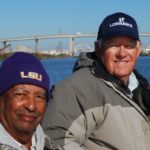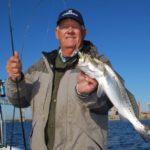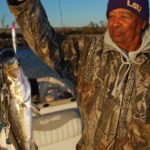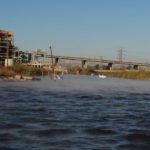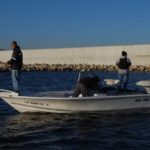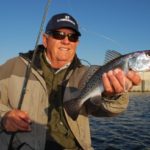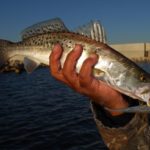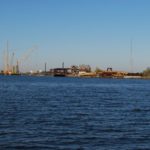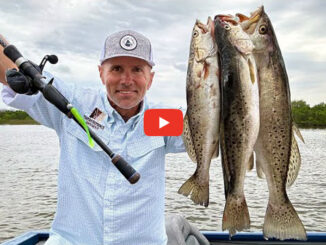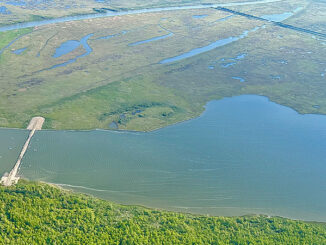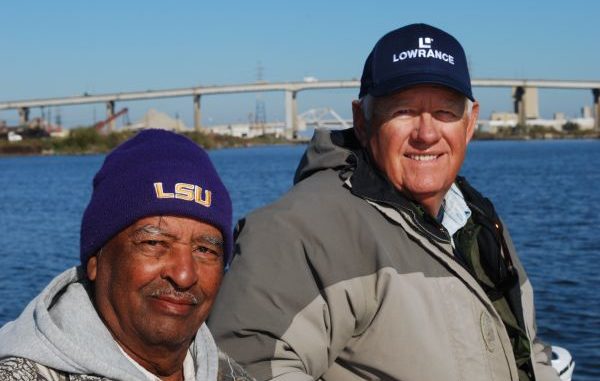
These two angles seem like polar opposites – but they share a love for all things trout fishing. Here’s how they continue to catch fish before Lake Pontchartrain turns on.
The big, fair-skinned, bluff man looked at me level in the eyes as he spoke.
“The worse the weather is, the better the fish bite,” he said. “We never have found it too cold to catch fish there — period!”
I couldn’t believe he was talking about speckled trout, but I knew he was. The area he was speaking about is closely connected to Lake Pontchartrain and “everybody knows” that 50 degrees is the magic mark for lake trout. Below that number, the fish just don’t bite, and legions of speckled trout anglers simply hang up their rods until April.
But not these two; they don’t hang them up. The speaker was Bob Weiss, simply known to most Lake Pontchartrain speckled trout anglers as “Doc.” In another life — before 2006 — he was a physician with a successful family practice in Slidell.
His partner, who was nodding in affirmation at Weiss’ every word, was Allen Sumas Jr., better known to everyone in the trout world as “Chink.”
Sumas, who retired as a New Orleans master plasterer in 2000, became one of the stars in the popular book Trout Masters: How Louisiana’s Best Anglers Catch the Lunkers.
Maybe my skepticism showed. So they offered to give me a grand fishing tour to sample the best spots in an area loosely called “Bayou Bienvenue,” although most of the fishing is in the Mississippi River Gulf Outlet and the Intracoastal Waterway.
It was cold, very cold, when we launched at Eddie’s off Paris Road just below the Seaway Bridge. This will give their claim a good test, I thought as my every breath puffed a cloud of steam.
As he readied his boat, Weiss cautioned me that during periods of extreme high tides that threaten to flood Paris Road businesses, the old Bayou Bienvenue locks into MRGO will close and anglers must launch at Chef Harbor or Venetian Isles and make the run down the ICW.
He also noted that the locks closed for maintenance work in December, and would remain so for a minimum of three months. The locks remained closed as of early February. Anglers are advised to call 504-286-3100, extension 1040 for the status of lock closures.
First stop for the two men was the eastern side (the side facing Breton Sound) of the Inner Harbor Navigation Canal Lake Borgne Surge Barrier, usually called the “The Great Wall” or more prosaically “The Wall” by fishermen.
The target, to start, wasn’t the wall itself, but rather the rock riprap along the southwestern side of the huge deactivated waterway.
Weiss threw a Lucky Craft Pointer Minnow, something that the manufacturer calls a “rip bait” but that he calls a suspending jerk bait. Sumas started with soft plastic — a blue moon Deadly Dudley straight tail on a 3/8-ounce jighead.
Weiss connected first with a 15-inch speck. He looked at Sumas out of the corner of his eye as he made his second cast, which produced a 1 ¾-pounder.
“Chink …,” he left the sentence unfinished.
While his unruffled partner quietly fished a Rapala X-Rap, a suspending slash bait out of his stash, Weiss explained that they fish with suspending lures a lot in cold weather. Sumas immediately connected with his Rapala, iced the fish and hooked another while Weiss talked about suspending lures.
“The important thing about fishing suspended baits is how you do the twitch-twitch-pause routine,” Weiss said. “The longer the pause, the better, right Chink?”
Sumas silently nodded in agreement while he unhooked his fish.
Weiss added that another favorite suspending lure of his is the MirrOdine XL made by MirrOlure.
“I almost always use hot pink or chartreuse colors,” he said as reached down and grabbed a tangle of the lures from his box to demonstrate. “Right Chink?”
Sumas agreed, then allowed that his preference in lures will always be soft plastics over all other artificials.
“It’s just something that I have confidence in over the years,” he said.
Sumas had pulled ahead on the body count while Weiss was talking. Weiss eyed him and whispered, “Can I put you on fish, Chink?”
His partner didn’t turn around or answer, but out of sight of Weiss, he rolled his eyes slightly and grinned.
Weiss jockeyed the bay boat back and forth over the same rock-strewn bank while both men caught fish. Sumas had gotten confident and replaced his Rapala with his favorite —the blue moon Deadly Dudley straight tail.
He was keeping up with Weiss, but his lure had an odd appearance.
A closer look revealed that he had wrapped the part of the plastic tail through which the hook was stabbed with clear Saran wrap and tied it on with monofilament.
“It makes the bait last longer,” Sumas explained matter-of-factly, “and, hey, it works.”
Weiss looked over his shoulder.
“It probably catches fish in spite of it rather than because of it,” he dryly observed.
The lures they were using revealed much about the two men and their background. Sumas is conservative, having come up poor in the Seventh Ward of New Orleans.
“I had 11 pair of pants. You know what that means — 1 pair on and 1 pair off,” he said.
He became a master plasterer.
Weiss grew up in the City Park area of New Orleans, one block off Esplanade Avenue. His father was a salesman, and the family was by his description “very middle income.” It was enough to send him to LSU Medical School.
He became a medical doctor.
Today, Weiss was fishing with $16 suspending lures. Sumas was using Saran-wrapped soft plastics.
Yet the pair have become fast friends. They are probably the only people who can keep up with each other’s fishing habits — 250 to 300 days a year.
“The only thing that keeps me from fishing are my family obligations and weather,” Weiss explained. “We just gradually started fishing together more and more, and we have never had a cross word — almost like an old married couple.
“We are not just close fishing-wise; we have become personally close.”
Sumas agreed.
“We love one another,” he said, “because we both love to catch fish. My opinion means something to him and his means something to me.
“The first time I ever saw Doc, I said, ‘I feel sorry for him: We’re catching fish and he’s not.’ Dudley [Vandenborre] said, ‘Don’t feel to sorry, he’s a genius at catching fish.’”
Weiss said that the first time he became aware of Sumas was a Seabrook (the outfall of the Industrial Canal into Lake Pontchartrain).
“By reputation, I knew that Chink was the expert at Seabrook,” Weiss said. “He would be the first one to leave with his limit, usually by 9 a.m. He would tell everyone goodbye with ‘It’s biscuit time.’
“My impression was that he was very competent in the nuances of Seabrook.”
They are much alike in some ways. Each has a strong ego and full confidence in his ability to catch fish. Each has a dominant personality, and is used to being the absolute captain of his boat, which makes their partnership even more remarkable.
Weiss is loquacious and articulate — used to using his command of the English language to prevail. Sumas can be much quieter, and can shut conversation down unbudgingly if it is going where he doesn’t want it to go.
Simultaneously, as if cued, both expressed boredom with fishing the spot. Weiss cranked the big motor to idle the boat the few hundred yards over to near the face of the big wall.
The wall was huge; there’s no other way to describe it. With the morning sun on its eastern face, it looked more like granite than concrete. It’s like what the barbarians must have faced when they tried to invade China from the north.
The wall provides good trout fishing, said Sumas, from when it first gets cold in October through March. But they don’t fish directly on it often, he revealed, because the average-sized fish is too small.
Weiss threw his suspending lure a while before shifting over to join Sumas with soft plastic. The latter bait allowed better presentation on or near the bottom, where the fish seemed to be.
His choice of lures was a midnight mullet Matrix Shad soft plastic on a jighead. Both men confessed to using this lure and the Deadly Dudley plastics interchangeably. Their favorite Deadly Dudley color is blue moon, and their three Matrix Shad favorites are lemon head, midnight mullet and shrimp Creole.
The fish were here alright, but somewhat smaller. Few were over 15 inches, although few were under legal size either. Surprisingly, most of their hits came well out from the big concrete slab of a wall.
The smaller fish rapidly caused the men to lose interest. Besides they had promised me a grand tour. So Weiss cradled the trolling motor, ran through the Bayou Bienvenue locks in the wall and curled the boat back to its south end.
“We’ll catch them every cast here, but they will be small,” Weiss predicted during the short run.
This side of the wall, the inside or west side, looked dramatically different than the other side. It was buttressed with large, diagonal pipes to help the wall resist storm surges. Weiss was right and wrong about the trout here: They did catch them every cast, but they were tiny.
Maybe one in seven or eight was legal, and then only barely. Everywhere they moved, they caught fish, all small.
For the next stop, they motored back through the same locks and turned sharply to the left. Their target was the arching southern bank of the MRGO starting after the entrance to the old Bayou Bienvenue locks and following the same bank to right before the high Paris Road Bridge spanning the ICW.
“The fish really stack up in here at times,” said Weiss expectantly. “For this spot the colder it is, the better it is.”
Sumas agreed, adding that he has caught trout hugging the bottom so tightly that “their bellies were slimed with clay.”
Even when it is bitter cold, the pair target waters 6 feet deep on the shoulder of the 40-foot deep channel. Both agreed that fishing deeper water is unproductive, no matter how cold it is.
Here, they alternately trolled and casted. When they casted, they used double-rig Matix Shads on 3/8-ounce jigheads. Trolling was done with the trolling motor set straight ahead for propulsion and the big boat motor used for dead-stick steering. Each man held his rod firmly to be ready to set the hook.
Both tactics produced speckled trout, decent fish in the order of what they caught first thing in the morning. This was the third spot of the day that would have produced limits for the pair if they had stayed, but duty called.
After all, they promised to provide a grand tour.
The run to the next spot, where the Inner Harbor Navigation Canal (aka the Industrial Canal) intersects the ICW was a little longer. On the way, they passed another hotspot on the northern shoulder of the ICW simply known as “Boh Brothers.” Here the waterway is a bulkheaded, working industrial area.
Best fishing is done off the rock riprap off of either the western or eastern end of the bulkhead.
Sumas noted fondly that this was the spot where his son Allen and he caught a 9-pound-2-ounce and a 9-pound-3-ounce speck within minutes of each other. They were using hook-caught croakers for bait, since no live bait was for sale in the early spring.
A hundred yards into the Industrial Canal, Weiss dropped his trolling motor, and both men began offering tandem-rigged Matrix Shads.
But the fishing was slower than at the other spots. So, with time running out and only time for one more stop, they ran back to the east in the ICW to the Hot Water Canal.
Aptly named, the short canal diagonals off the northern bank of the ICW just east of the bridge over the ICW. At its terminal end sits an Entergy power plant that discharges its heated cooling water into the canal.
On a cold day like today, the canal was shrouded in steam and packed with boats taking advantage of the fish clustering in the canal to escape the cold.
It was time to go. And I hadn’t seen it all.
“That’s one of the wonderful things about fishing this area,” cooed Weiss soothingly. “You run out of time before you run out of good places to fish — the Industrial Canal, the Intracoastal Waterway, Mr. Go, the Michaud Slip, the Hot Water Canal, Boh Brothers, the Air Products Canal — a variety of habitats; deep water, shallow water, rocks and marsh.”
It has it all.
